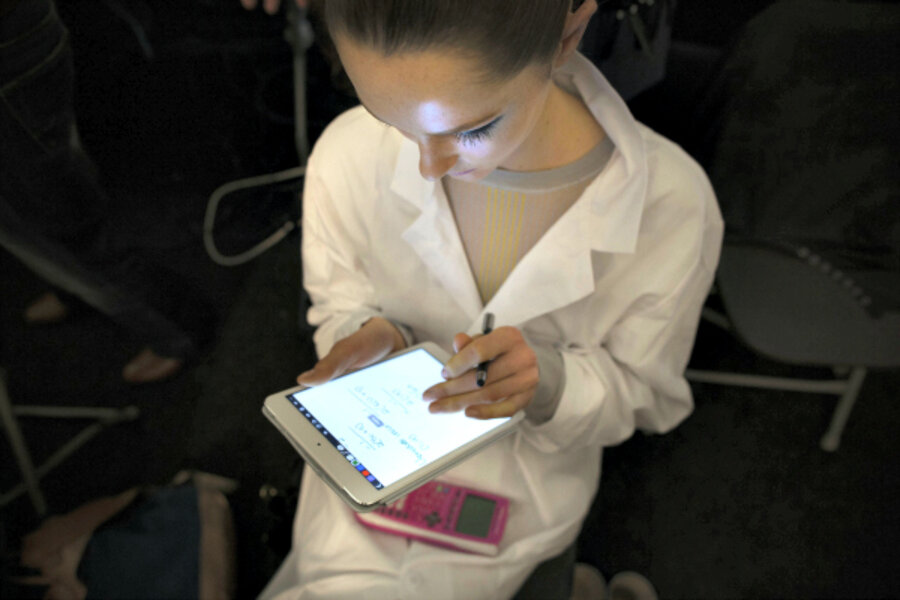Girls just want to have fun ... in high-tech careers
Loading...
The stereotype “computer geek” carries with it the usual accoutrements: glasses, game consoles, and lots of alone time. Even as technology has become ubiquitous through social networks and smartphones, one part of that image has remained constant – the geeks are typically guys.
The economic landscape supports this representation. According to a report issued by the US Department of Commerce in 2011, women made up approximately half of the US workforce, but held less than 25 percent of the jobs in science, technology, engineering, and math.
This is troubling in an age when technical innovation is crucial to almost all sectors of the economy. While computing professions are growing at almost twice the rate of the average for all occupations, the National Center for Women & Information Technology estimates that by 2018, the industry will only be able to fill half of its open jobs.
Reshma Saujani founded Girls Who Code (GWC) hoping to recruit women to fill some of these vacancies. On the campaign trail for a congressional seat in 2010, she observed the power of technology in communities of all socioeconomic levels. Despite the growing number of opportunities in tech-related fields, girls didn’t seem to be interested.
“I realized that we needed to do something about it, and we needed to start young, focusing on teenage girls, before they’ve figured out what they want to do with their lives,” she said.
At the time there was no existing computer science curriculum tailored to teenage girls, so she assembled a think tank of techies from companies like Microsoft and Google, and set out to create one.
“When girls think about computer science, they think about a guy in front of a computer typing,” Ms. Saujani said. The program aimed to supplant this by focusing on what technology roles could produce in girls’ own lives.
The first GWC program launched in the summer of 2012 with 22 girls in New York City. Courses covered not only coding but pitching and presentation skills. At the outset, only one participant was considering a major in computer science; by the end, the entire class planned to major or minor in the subject.
Saujani hopes this will support the girls in their future entrepreneurial ventures, as websites and mobile apps have become near requirements for new businesses.
“Research shows that girls pick areas of study that enable them to change the world. We’re showing them how to build things that help them achieve that.”
In 2013, Girls Who Code will expand to Detroit, San Jose, Calif., and Miami, due in part to a grant from the Knight Foundation.
Paula Ellis, former vice president of the foundation, began her career as a journalist when there were few women in the news industry. She believes that introducing girls to female mentors is an important step to breaking gender barriers. “Mentoring is a really strong way to support a girl’s interest or a woman’s career. It’s the fact that you can see that you can do this. [GWC’s] model is pretty simple – it’s exposure to what’s possible.”
Female role models help break down the idea that males are inherently more skilled at math and science, a belief that deters women from classes and careers in these fields. Even Saujani, whose parents were both engineers, says she was afraid of math and science, convinced that she wasn’t good at them.
But Carolyn Chandler, former adjunct professor for DePaul’s Human-Computer Interaction program and co-author of a book on UX design, argues that technology represents much more than cold numbers. She credits her background in anthropology with influencing her work in creating user-friendly online experiences. “Women tend to be very socially aware and designing requires that as a skill, to be interested in gaining the empathy of the folks you’re designing for and trying to solve problems with that human element.”
She points to research linking collective intelligence with the number of females in a group. The study found that women’s social sensitivity positively affected group cooperation, improving overall performance.
In contrast to the image of a lone programmer, Chandler champions teamwork, encouraging women to share their ideas and attend meetups outside of work. For her, the field opened up when she stopped feeling intimidated by the male-dominated industry.
“I started to feel not like a woman among men, but a designer among designers, a developer among developers,” she said.
Gender or otherwise, Ellis agrees that technology will benefit from teams of diverse individuals. “Everybody has something unique to add. When we all see something from a different perspective, and we share that perspective, something creative and new happens. We better represent the world.”







